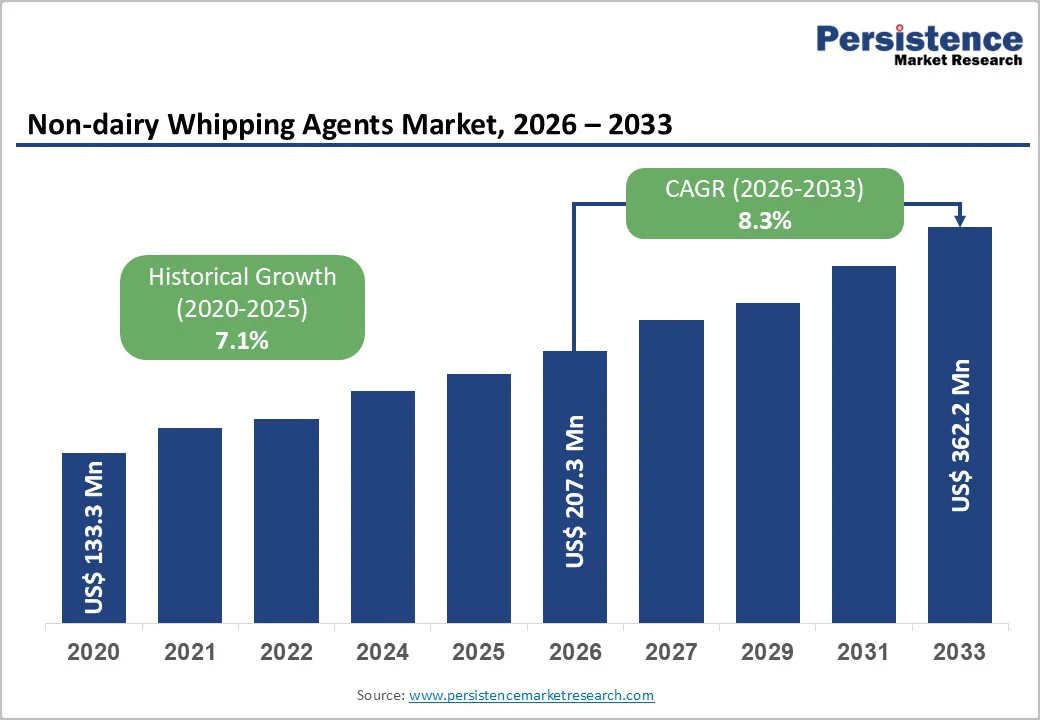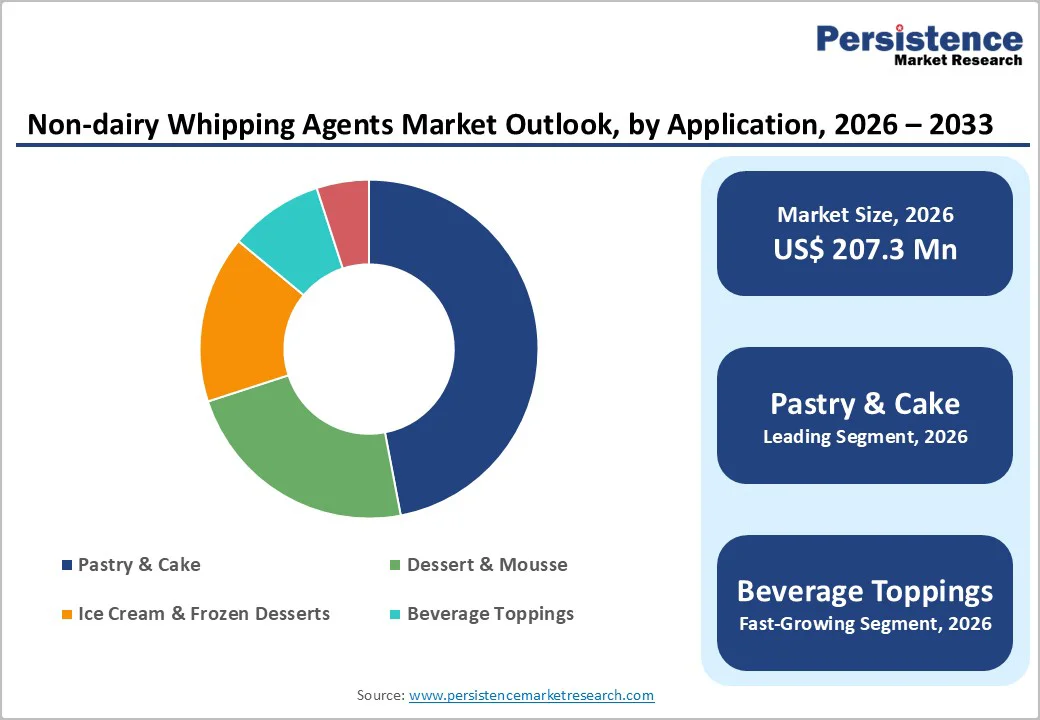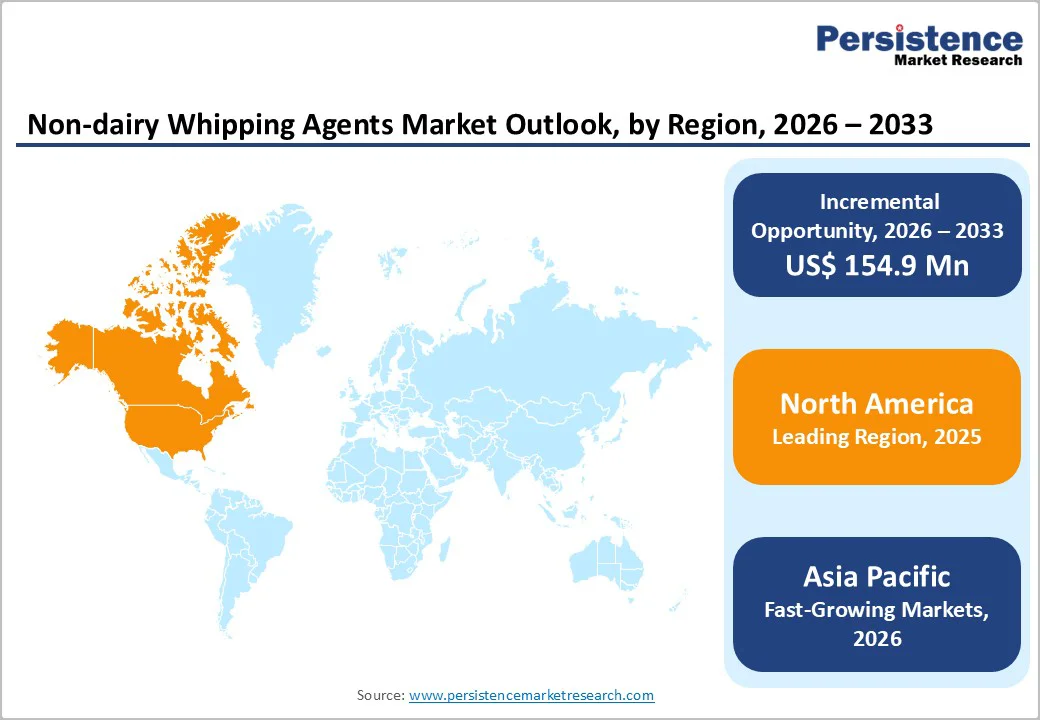ID: PMRREP25918| 220 Pages | 16 Dec 2025 | Format: PDF, Excel, PPT* | Food and Beverages

The global non-dairy whipping agents market size is estimated to grow from US$ 207.3 million in 2026 to reach US$ 362.2 million by 2033, growing at a CAGR of 8.3% during the forecast period from 2026 to 2033.
The global market is transforming as plant-based lifestyles and clean-label demand accelerate adoption across bakery, dessert, and beverage applications. Innovations in ingredients, formulations, and flavors create exciting opportunities for both established players and emerging startups.
| Key Insights | Details |
|---|---|
| Global Non-dairy Whipping Agents Market Size (2026E) | US$ 207.3 Mn |
| Market Value Forecast (2033F) | US$ 362.2 Mn |
| Projected Growth (CAGR 2026 to 2033) | 8.3% |
| Historical Market Growth (CAGR 2020 to 2025) | 7.1% |

An accelerating dietary shift is unfolding as rising lactose intolerance and growing dairy avoidance push consumers toward plant-based whipping solutions. This transition is reshaping the non-dairy whipping agents market, driven by demand for products that offer clean digestion, allergen-friendly profiles, and versatile functionality across bakery, desserts, and beverages.
Consumers seeking lighter, stomach-friendly alternatives increasingly choose coconut, oat, soy, and pea-based whipping systems that deliver stable aeration, smooth texture, and strong whipping performance. Foodservice operators, home bakers, and industrial manufacturers are broadening their use of non-dairy agents to meet evolving customer expectations for inclusive and digestion-safe products.
As intolerance rates climb globally, plant-based whipping formats gain momentum, strengthening their position in modern food formulation.
Cold-chain limitations across emerging markets are creating a persistent bottleneck for frozen and ready-to-whip non-dairy whipping products. In several regions, temperature inconsistencies during transport, storage, and last-mile delivery compromise product stability, leading to texture breakdown, reduced aeration performance, and shortened shelf life.
Retailers and small bakeries struggle with unreliable refrigeration, lowering their willingness to stock higher-value frozen whipping agents. Logistics providers face fragmented infrastructure, limited insulated fleets, and frequent power interruptions, which raise operational risks for manufacturers targeting fast-growing urban centers.
As cold-chain reliability fluctuates, brands are forced to invest in reformulation, more robust packaging, or ambient-stable alternatives, ultimately slowing category expansion in markets with high volume potential.
Innovation in coconut, oat, and pea-based whipping systems is opening a decisive window for brands aiming to build premium, future-ready portfolios in the non-dairy whipping agents market.
As consumers look for richer textures, clean-label claims, and allergen-friendly options, these bases provide versatile platforms for creating differentiated products with superior aeration, stability, and mouthfeel. Coconut brings natural creaminess, oat supports neutral flavor profiles ideal for bakery applications, and pea delivers protein-rich formulations suited for high-performance whipping.
Startups can leverage these ingredients to craft signature blends tailored to artisanal desserts, cafés, and gourmet retail. Established players can push R&D toward advanced emulsification and foaming technologies, enabling next-generation whipping agents that elevate both indulgence and functionality.
Pastry & cake hold approx. 47% share as of 2025, reflecting its position as the core application driving global demand for non-dairy whipping agents. This dominance comes from the segment’s constant need for stable aeration, high-volume whip, and clean flavor carryover, making plant-based whipping systems ideal for layered cakes, premium pastries, and decorative finishes.
Bakers favor these formulations for their consistency across varying temperatures and faster preparation times. Dessert & mousse applications continue gaining traction as chefs adopt lighter, allergen-friendly textures for modern plated desserts. Ice-cream & frozen desserts are expanding through dairy-free indulgence trends, while beverage toppings benefit from café chains and home baristas seeking long-lasting foams for coffees, frappes, and cold beverages.
Specialty stores are projected to achieve a CAGR of 8.7% during the forecast period, driven by their ability to curate premium, niche, and high-performance formulations that mainstream retail often overlooks. Consumers seeking allergen-free, vegan, or advanced whipping solutions increasingly rely on these outlets for expert recommendations and product transparency.
Specialty stores excel at showcasing innovations such as coconut-, oat-, and pea-based whipping blends through in-store demos, bakery partnerships, and hands-on education. Their focused assortments attract professional bakers, café operators, and hobby confectioners who value consistency and technical performance.
As demand accelerates for clean-label, functional whipping agents tailored to pastry, dessert, and beverage applications, specialty stores are positioned to capture sustained, quality-driven growth.

North America remains the leading market, accounting for 42% in 2025, driven by increasing consumer demand for plant-based lifestyles and dairy-free treats across the United States and Canada. In the U.S., rising lactose intolerance and growing health awareness are pushing consumers toward non-dairy whipping agents for desserts, coffee drinks, and bakery products.
In Canada, a similar shift toward flexitarian and vegan diets is prompting foodservice chains and cafes to add non-dairy whipped toppings, expanding availability from specialty stores to mainstream retail. Meanwhile, new formulations featuring soy, coconut, and almond-based creams with cleaner labels and better whipping performance are making dairy-free options more appealing to traditional whipped cream users.
Asia Pacific non-dairy whipping agents market is expected to achieve a CAGR of 8.9% in the forecast period. Across China, rising middle-class urban population are turning to plant-based desserts, and specialty cafés are increasingly offering soy and coconut whipped toppings to attract younger consumers. In India, growing awareness around lactose intolerance and dietary wellness leads home bakers to adopt almond-based whipping agents for cakes and pastries.
In Japan, demand for clean-label, additive-free alternatives supports the growth of rice- and soy-derived creams suited for delicate confectionery textures. Indonesia and South Korea are seeing expansion of chilled plant-cream products in cafés and ice-cream parlors, especially for vegan and dairy-free menus. Regional dietary shifts toward flexibility and allergy-friendly options drive innovation in taste and performance. Rapid growth expected.

The global non?dairy whipping agents market exhibits a moderately consolidated competitive landscape, with established players and nimble newcomers competing for prominence.
Leading companies are emphasizing clean-label raw materials, using coconut, oat, almond, and pea-based ingredients alongside plant-derived emulsifiers to appeal to health-conscious consumers. Product development focuses on stability, texture, and flavor to replicate traditional dairy performance. B2B expansion is expanding reach into bakeries, cafés, and industrial foodservice channels.
Collaborations with artisan producers enable co-created specialty desserts that showcase non-dairy whipping capabilities. Flavor innovation, including vanilla, chocolate, and seasonal varieties, is enhancing consumer appeal. Companies that integrate clean formulations, targeted B2B strategies, and unique flavor offerings are solidifying leadership, while others risk lagging behind in an increasingly dynamic market.
The global non-dairy whipping agents market is projected to be valued at US$ 207.3 Mn in 2026.
Growing lactose intolerance and increasing dairy-sensitive consumers are pushing demand for plant-based whipping agents across global markets.
The global non-dairy whipping agents market is poised to witness a CAGR of 8.3% between 2026 and 2033.
New formulation breakthroughs in coconut, oat, and pea-based bases are opening opportunities for premium, high-value product differentiation.
Major players in the global non-dairy whipping agents market include Rich Products Corporation, Puratos Group, FrieslandCampina Professional, Kerry Group, Dawn Foods, Ingredion, Ashland, Danone, and others.
| Report Attribute | Details |
|---|---|
| Historical Data/Actuals | 2020 - 2025 |
| Forecast Period | 2026 - 2033 |
| Market Analysis | Value: US$ Mn |
| Geographical Coverage |
|
| Segmental Coverage |
|
| Competitive Analysis |
|
| Report Highlights |
|
By Form
By Application
By Distribution Channel
By Region
Delivery Timelines
For more information on this report and its delivery timelines please get in touch with our sales team.
About Author